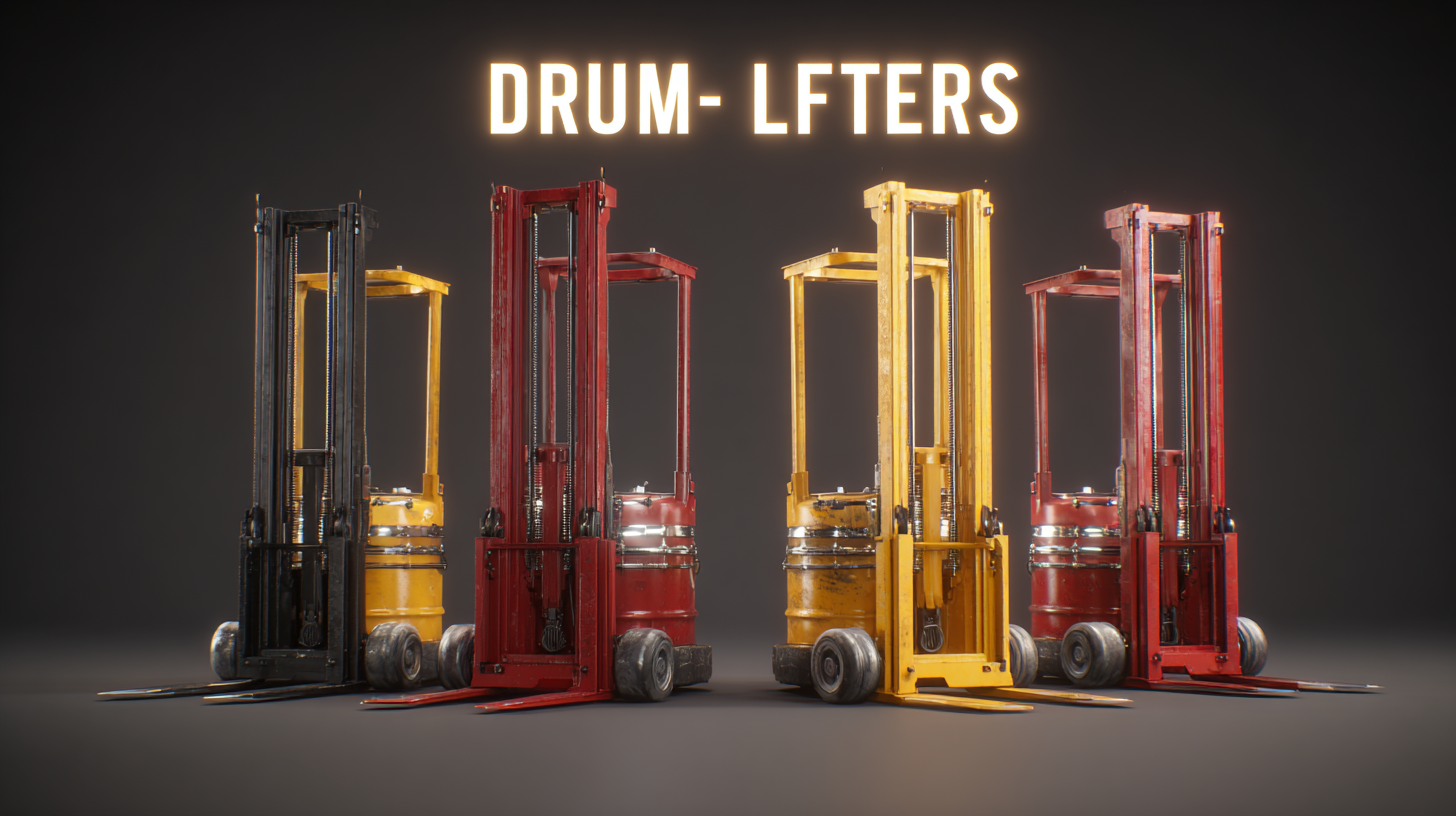Challenges Associated with Selecting the Best Drum Lifters for Your Needs
Selecting the best drum lifters for your needs presents a unique set of challenges that can significantly impact efficiency and safety in various industrial applications. According to a report by the Occupational Safety and Health Administration (OSHA), improper handling of drum containers can lead to significant workplace injuries, accounting for nearly 35% of all material handling incidents. Furthermore, a survey by the National Safety Council indicates that organizations employing effective drum handling solutions can reduce accident rates by up to 40%. With the wide variety of drum lifters available on the market, including electric, manual, and pneumatic options, it becomes essential to carefully consider the specific requirements of your operation. Factors such as load capacity, ergonomic design, and compatibility with different drum sizes not only influence operational efficiency but also worker safety. In this blog, we will explore these challenges and provide insights to help you make an informed decision when selecting drum lifters tailored to your unique needs.

Understanding Industry Standards for Drum Lifters and Their Importance
When selecting drum lifters for your specific needs, understanding industry standards is crucial to ensure safety and efficiency. Drum lifters must meet recognized regulations and guidelines to safeguard users and equipment. These standards cover various aspects, including design specifications, load capacities, and operational protocols. By adhering to these standards, you can mitigate risks associated with improper lifting techniques or equipment failures, which can lead to severe injuries or costly damages.
Industry standards not only ensure safety in operation but also enhance the overall reliability of the equipment. As we approach the winter season, it's a pertinent time to evaluate and reinforce maintenance practices in your facility. Just as with vehicle lifts, the importance of selecting a drum lifter that complies with safety regulations cannot be overstated. Organizations like the Automotive Lift Institute emphasize the need for thorough research and careful consideration when purchasing any lifting equipment. This diligence not only supports worker safety but also contributes to the longevity and performance of the lifters in your operational environment.
Key Features to Consider When Selecting Drum Lifters for Your Application
When selecting the best drum lifters for your application, it’s essential to consider several key features that can significantly influence efficiency and safety. According to a report from the Material Handling Industry of America, selecting the right lifting equipment can reduce workplace injuries by up to 60%. Therefore, it's crucial to assess the weight capacity, lift height, and the specific design of the drum lifter. Many operations will require lifters that can accommodate standard 55-gallon drums, which typically weigh between 400 to 500 pounds when full.
Another important factor to consider is the method of operation. Electric drum lifters offer advantages in terms of speed and ease of use, particularly for applications that involve frequent lifting. Meanwhile, manual lifters are suitable for low-frequency operations but require more physical effort. As highlighted by OSHA guidelines, ergonomically designed drum lifters can help minimize the risk of injury and enhance productivity.
Tip: Before making a purchase, ensure that the drum lifter you choose has a non-slip grip and stability features to enhance safety during operation. Additionally, always review user feedback and ratings to gauge the reliability of the equipment. Investing in high-quality drum lifters not only improves operational efficiency but also promotes a safer work environment.
Challenges Associated with Selecting the Best Drum Lifters for Your Needs - Key Features to Consider When Selecting Drum Lifters for Your Application
| Feature | Description | Importance |
|---|---|---|
| Weight Capacity | The maximum weight a drum lifter can handle safely. | Crucial for different drum weights and materials. |
| Material | The construction material of the lifter, affecting durability. | Important for longevity and resistance to corrosion. |
| Versatility | Ability to lift various types of drums (e.g., plastic, steel). | Helps in multi-purpose applications. |
| Safety Features | In-built safety mechanisms to prevent accidents during lifting. | Essential for worker protection and compliance with regulations. |
| Ease of Use | User-friendliness of the drum lifter, including mobility and operation. | Reduces training time and enhances efficiency. |
| Maintenance Requirements | How often the lifter needs to be serviced or inspected. | Lower maintenance can reduce overall operational costs. |
Common Challenges in Choosing the Right Drum Lifters
Choosing the right drum lifter can be a daunting task, particularly because of the variety of options available. One common challenge is understanding the specific application requirements. Different environments—such as factories, warehouses, or construction sites—may demand different features. For instance, a drum lifter used in a tight space may need to be compact and highly maneuverable, while one used outdoors might require durability against harsh weather conditions.
Another significant challenge is ensuring compatibility with the type of drums you intend to handle. Drum lifters are designed for specific drum sizes and weights, and failing to match these specifications can lead to inefficiency and unsafe handling. Additionally, considering the ergonomics of the lifter is vital; it should minimize strain on the operator. A poorly designed lifter can lead to fatigue and even injuries over time. Therefore, evaluating performance, safety features, and user-friendliness are key factors in the decision-making process when selecting drum lifters that best suit your operational needs.

Comparative Analysis of Drum Lifters: Manual vs. Powered Options
When selecting drum lifters, it’s essential to understand the fundamental differences between manual and powered options. Manual drum lifters require physical strength and technique, making them suitable for environments where quick, low-frequency lifting is needed. However, they can also be labor-intensive and might lead to safety risks, particularly if proper lifting techniques aren't employed. Operating a manual lifter requires training to ensure compliance with safety regulations, emphasizing the importance of ergonomic practices.
On the other hand, powered drum lifters present a modern solution, offering increased efficiency, particularly for heavy or bulky drums. These electric or pneumatic options can significantly reduce the physical strain on workers and improve productivity by allowing one person to handle more substantial loads. However, it's vital to assess the power source and maintenance requirements, as they can vary widely among models.
**Tips:** When choosing between manual and powered drum lifters, consider the average weight of the drums and frequency of use. Always ensure the chosen model aligns with workplace safety standards. Additionally, try to involve your team in the selection process to gather insights on usability and comfort, ensuring the equipment fits the specific needs of your operations.
Comparative Analysis of Drum Lifters: Manual vs. Powered Options
Tips for Ensuring Safety and Compliance When Using Drum Lifters
When selecting drum lifters for industrial use, ensuring safety and compliance should be at the forefront of your decision-making process. According to the Occupational Safety and Health Administration (OSHA), improper lifting techniques and equipment can lead to significant workplace injuries, contributing to over 100,000 lifting-related injuries annually in the United States alone. To mitigate these risks, it is essential to choose drum lifters that are certified and meet the relevant safety standards.
One effective tip for ensuring safe operation is to regularly inspect your drum lifters for wear and tear. A study by the National Institute for Occupational Safety and Health (NIOSH) found that regularly maintained equipment can reduce the risk of accidents by up to 30%. Always ensure that your lifters have the appropriate weight ratings for the drums you will be using. Additionally, providing training for your staff on how to properly use drum lifters can significantly enhance safety. According to recent industry reports, workplaces that invest in employee training experience a 50% reduction in equipment-related incidents.
Moreover, always ensure that your drum lifters are compliant with relevant regulations, such as ANSI and ISO standards. Compliance not only guarantees safety but also protects your company from potential legal repercussions. Utilizing drum lifters that have undergone rigorous testing and adhere to these standards will safeguard both your employees and your operational efficiency.


